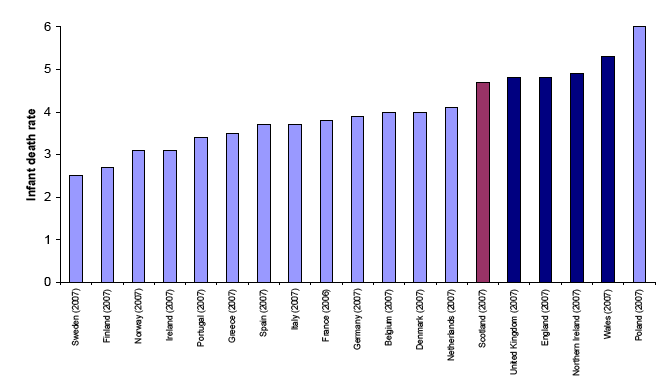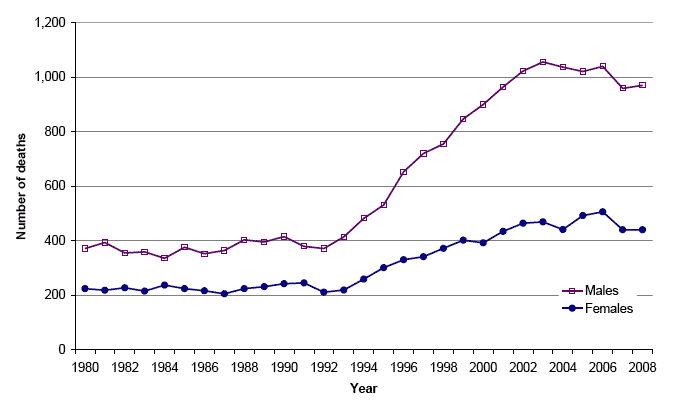
Numbers
55,700 deaths were registered in Scotland in 2008. This was 286 (0.5%) fewer than in 2007, and was the second lowest total recorded since the introduction of civil registration in 1855.
Figure 2.1 on page 25 shows that from 1951 up to the early 1990s the annual number of deaths remained relatively stable at about 60-65,000 a year. The total then declined slowly to just under 55,100 in 2006, which was the lowest annual total recorded.
Causes of death
Table 3.1 shows major causes of deaths, by age group. In 2008 more than half of all deaths were due to the so-called "three big killers". There were 15,269 deaths from cancer, (27 per cent of all deaths), 8,841 deaths from ischaemic (coronary) heart disease, (16 per cent of all deaths) and 5,367 deaths from cerebrovascular disease (stroke) (10% of all deaths).
Since 1980, the numbers of deaths from these causes have changed, as shown in Table 3.2. The percentage of deaths accounted for by the so-called "three big killers" was 65% in 1981 and 1991, falling through 61% in 1996 and 59% in 2001 to 53% in 2008. The proportion of deaths caused by ischaemic heart disease has fallen from 29% in 1981 to 16% in 2008, and cerebrovascular disease declined from 14% to 10%, whereas the proportion caused by cancer has risen from 22% to 27%.
Cancer
Of the 15,269 deaths from cancer in 2008, cancer of the trachea, bronchus and lung was the most common type, accounting for over a quarter (27 per cent) of all cancer deaths.
The next most frequent type of cancer death was bowel for men (839 deaths, of which 44 per cent were aged 75 and over) and breast for women (1,043 deaths, of which 45 per cent were aged 75 and over). Death rates for these two causes have been relatively stable in recent years. Cancers of the lymphoid, haematopoietic and related tissue caused 1,002 deaths and prostate cancer caused 792 deaths.
Death rates, by sex, for some of the most common causes of death are shown in Table 3.3. Over the last 25 years or so, male death rates from lung cancer have fallen by almost 30 per cent (from 119 per 100,000 population in 1980-82 to 85 in 2008). By contrast, the rates for women, though still lower than those for men, have increased by 80 per cent (from 41 per 100,000 population in 1980-82 to 74 in 2008).
Table 3.1 The most common1 causes of death, Scotland, 2008
Persons |
All ages |
0-14 |
15-34 |
35-44 |
45-54 |
55-64 |
65-74 |
75+ |
|---|---|---|---|---|---|---|---|---|
All cancers (C00-97) |
15,269 |
19 |
79 |
267 |
877 |
2,391 |
4,291 |
7,345 |
Trachea, bronchus and lung (C33-34) |
4,080 |
- |
4 |
22 |
197 |
706 |
1,351 |
1,800 |
Bowel (C18-21) |
1,585 |
- |
3 |
29 |
85 |
237 |
450 |
781 |
Breast (C50) |
1,050 |
- |
4 |
61 |
113 |
179 |
217 |
476 |
Lymphoid, haematopoietic etc (C81-96) |
1,002 |
4 |
20 |
18 |
39 |
121 |
279 |
521 |
Urinary tract (C64-68) |
875 |
- |
1 |
10 |
34 |
108 |
237 |
485 |
Oesophagus (C15) |
831 |
- |
- |
13 |
61 |
149 |
241 |
367 |
Prostate (C61) |
792 |
- |
- |
- |
8 |
62 |
189 |
533 |
Pancreas (C25) |
642 |
- |
- |
10 |
41 |
108 |
181 |
302 |
Stomach (C16) |
511 |
- |
- |
9 |
27 |
65 |
129 |
281 |
Other cancers (e.g. bladder, liver, ovary) |
3,901 |
15 |
47 |
95 |
272 |
656 |
1017 |
1,799 |
Ischaemic heart disease (I20-25) |
8,841 |
- |
14 |
115 |
399 |
971 |
1,834 |
5,508 |
Respiratory system diseases (J00-99) |
7,443 |
13 |
25 |
41 |
127 |
501 |
1,229 |
5,507 |
Cereberovascular disease (I60-69) |
5,367 |
3 |
15 |
49 |
131 |
275 |
705 |
4,189 |
Mental + behavioural disorders (F00-99) |
3,362 |
- |
238 |
198 |
134 |
123 |
189 |
2,480 |
Diseases of the digestive system (K00-93) |
3,119 |
2 |
40 |
178 |
403 |
540 |
573 |
1,383 |
Diseases of the nervous system (G00-99) |
1,613 |
21 |
62 |
44 |
86 |
147 |
296 |
957 |
Diseases of the genitourinary system (N00-99) |
1,279 |
- |
3 |
9 |
13 |
48 |
171 |
1,035 |
Accidents (V01-X59,Y85-86) |
1,261 |
23 |
179 |
80 |
122 |
114 |
115 |
628 |
Endocrine, nutritional and metabolic diseases (E00-90) |
991 |
12 |
28 |
26 |
70 |
112 |
212 |
531 |
Certain infectious and parasitic diseases (A00-B99) |
936 |
7 |
16 |
29 |
42 |
52 |
147 |
643 |
Males |
All ages |
0-14 |
15-34 |
35-44 |
45-54 |
55-64 |
65-74 |
75+ |
All cancers (C00-97) |
7,729 |
9 |
39 |
111 |
433 |
1,319 |
2,370 |
3,448 |
Trachea, bronchus and lung (C33-34) |
2,114 |
- |
1 |
11 |
98 |
400 |
726 |
878 |
Bowel (C18-21) |
839 |
- |
1 |
16 |
50 |
139 |
262 |
371 |
Breast (C50) |
7 |
- |
- |
1 |
- |
1 |
2 |
3 |
Lymphoid, haematopoietic etc (C81-96) |
539 |
3 |
15 |
8 |
28 |
75 |
167 |
243 |
Urinary tract (C64-68) |
525 |
- |
1 |
6 |
22 |
74 |
149 |
273 |
Oesophagus (C15) |
520 |
- |
- |
11 |
44 |
115 |
172 |
178 |
Prostate (C61) |
792 |
- |
- |
- |
8 |
62 |
189 |
533 |
Pancreas (C25) |
319 |
- |
- |
5 |
23 |
64 |
99 |
128 |
Stomach (C16) |
300 |
- |
- |
5 |
16 |
49 |
80 |
150 |
Other cancers (e.g. bladder, liver) |
1,774 |
6 |
21 |
48 |
144 |
340 |
524 |
691 |
Ischaemic heart disease (I20-25) |
4,852 |
- |
13 |
85 |
313 |
739 |
1,225 |
2,477 |
Respiratory system diseases (J00-99) |
3,276 |
7 |
13 |
18 |
70 |
255 |
664 |
2,249 |
Cereberovascular disease (I60-69) |
2,051 |
1 |
9 |
30 |
82 |
153 |
392 |
1,384 |
Mental + behavioural disorders (F00-99) |
1,335 |
- |
188 |
158 |
98 |
86 |
112 |
693 |
Diseases of the digestive system (K00-93) |
1,531 |
- |
22 |
106 |
258 |
324 |
323 |
498 |
Diseases of the nervous system (G00-99) |
717 |
10 |
35 |
25 |
49 |
78 |
155 |
365 |
Diseases of the genitourinary system (N00-99) |
511 |
- |
- |
4 |
6 |
27 |
83 |
391 |
Accidents (V01-X59,Y85-86) |
696 |
16 |
148 |
67 |
89 |
81 |
76 |
219 |
Endocrine, nutritional and metabolic diseases (E00-90) |
498 |
7 |
20 |
16 |
34 |
68 |
122 |
231 |
Certain infectious and parasitic diseases (A00-B99) |
380 |
4 |
7 |
13 |
31 |
34 |
57 |
234 |
Females |
All ages |
0-14 |
15-34 |
35-44 |
45-54 |
55-64 |
65-74 |
75+ |
All cancers (C00-97) |
7,540 |
10 |
40 |
156 |
444 |
1,072 |
1,921 |
3,897 |
Trachea, bronchus and lung (C33-34) |
1,966 |
- |
3 |
11 |
99 |
306 |
625 |
922 |
Bowel (C18-21) |
746 |
- |
2 |
13 |
35 |
98 |
188 |
410 |
Breast (C50) |
1,043 |
- |
4 |
60 |
113 |
178 |
215 |
473 |
Lymphoid, haematopoietic etc (C81-96) |
463 |
1 |
5 |
10 |
11 |
46 |
112 |
278 |
Urinary tract (C64-68) |
350 |
- |
- |
4 |
12 |
34 |
88 |
212 |
Oesophagus (C15) |
311 |
- |
- |
2 |
17 |
34 |
69 |
189 |
Pancreas (C25) |
323 |
- |
- |
5 |
18 |
44 |
82 |
174 |
Stomach (C16) |
211 |
- |
- |
4 |
11 |
16 |
49 |
131 |
Other cancers (e.g. bladder, liver, ovary) |
2,127 |
9 |
26 |
47 |
128 |
316 |
493 |
1108 |
Ischaemic heart disease (I20-25) |
3,989 |
- |
1 |
30 |
86 |
232 |
609 |
3,031 |
Respiratory system diseases (J00-99) |
4,167 |
6 |
12 |
23 |
57 |
246 |
565 |
3,258 |
Cereberovascular disease (I60-69) |
3,316 |
2 |
6 |
19 |
49 |
122 |
313 |
2,805 |
Mental + behavioural disorders (F00-99) |
2,027 |
- |
50 |
40 |
36 |
37 |
77 |
1,787 |
Diseases of the digestive system (K00-93) |
1,588 |
2 |
18 |
72 |
145 |
216 |
250 |
885 |
Diseases of the nervous system (G00-99) |
896 |
11 |
27 |
19 |
37 |
69 |
141 |
592 |
Diseases of the genitourinary system (N00-99) |
768 |
- |
3 |
5 |
7 |
21 |
88 |
644 |
Accidents (V01-X59,Y85-86) |
565 |
7 |
31 |
13 |
33 |
33 |
39 |
409 |
Endocrine, nutritional and metabolic diseases (E00-90) |
493 |
5 |
8 |
10 |
36 |
44 |
90 |
300 |
Certain infectious and parasitic diseases (A00-B99) |
556 |
3 |
9 |
16 |
11 |
18 |
90 |
409 |
1 The causes are listed in descending order of their total numbers of deaths. International Classification of Diseases codes (ICD10) are also shown.
Table 3.2 Number of deaths from selected causes, by sex, 1980-2008
Year |
Cancer |
Ischaemic heart disease |
Cerebrovascular disease |
|||
|---|---|---|---|---|---|---|
Males |
Females |
Males |
Females |
Males |
Females |
|
1980-821 |
7,269 |
6,634 |
10,173 |
8,150 |
3,470 |
5,638 |
1990-921 |
7,664 |
7,324 |
8,964 |
7,846 |
2,913 |
5,029 |
2000-021 |
7,674 |
7,394 |
6,342 |
5,664 |
2,465 |
4,250 |
2008 |
7,729 |
7,540 |
4,852 |
3,989 |
2,051 |
3,316 |
1 Average over 3 year period.
Table 3.3 Death rates from selected causes, by sex, Scotland, 1980-2008
Males - rates per 100,000 population
Cancer |
Ischaemic heart disease |
Cerebrovascular disease |
|||
|---|---|---|---|---|---|
All types |
Trachea, bronchus and lung |
Prostate |
|||
1980-821 |
291 |
119 |
19 |
408 |
139 |
1990-921 |
314 |
111 |
27 |
367 |
119 |
2000-021 |
321 |
93 |
32 |
261 |
101 |
2008 |
309 |
85 |
32 |
194 |
82 |
Females - rates per 100,000 population
Cancer |
Ischaemic heart disease |
Cerebrovascular disease |
|||
|---|---|---|---|---|---|
All types |
Trachea, bronchus and lung |
Breast |
|||
1980-821 |
247 |
41 |
45 |
304 |
210 |
1990-921 |
278 |
57 |
48 |
297 |
191 |
2000-021 |
288 |
64 |
43 |
216 |
162 |
2008 |
283 |
74 |
39 |
149 |
124 |
1 Average over 3 year period.
Heart disease and stroke
Table 3.3 shows that, in contrast to the rises for cancer, death rates for ischaemic heart disease (coronary heart disease) and cerebrovascular disease (stroke) have shown significant declines. Between 1980-82 and 2008, rates for males had improved by 52 per cent for ischaemic heart disease and 41 per cent for stroke compared with improvements of 51 and 41 per cent respectively for females.
Some other major causes of deaths
Other major causes of deaths registered in 2008 included:
Alcohol-related deaths
As well as alcoholic liver disease, there are numerous causes of death that are considered to be ‘alcohol-related’. The main additional category is ‘mental and behavioural disorders due to use of alcohol’. There are several other causes that are specifically alcohol related (e.g. alcoholic pancreatitis) as well as some (e.g. oesophageal cancer) where alcohol consumption is only responsible for a proportion of deaths. Following wide consultation, the Office for National Statistics (ONS) proposed a selection of diseases to be used for high-level public health monitoring of alcohol-related deaths. This includes only the causes of death which are regarded as most directly due to alcohol consumption and for which figures can be obtained from the death registration statistics. It does not include every kind of alcohol-related death: for example, it does not include deaths as a result of road accidents, falls, fires, suicide or violence involving people who had been drinking; or from some medical conditions which are considered partly attributable to alcohol.
On the basis of this definition, there were 1,411 alcohol related deaths in 2008. Figure 3.1 shows that the trends in alcohol-related deaths for both sexes were relatively stable during the 1980s, but there have been significant increases, particularly for men, since the early 1990s. Further analysis of the data shows that the number of deaths have generally been rising in all age groups, with the largest increases being among those aged 45-59. In recent years the number of deaths appears to level off.
The reasons underlying these changes are not fully understood, but changing social attitudes, increased affluence and relative price levels, and licensing changes are all thought to have contributed to increased alcohol consumption.
Further information about the definition, and a more detailed breakdown of the numbers of alcohol-related deaths is available from the General Register Office for Scotland (GROS) website, at: http://www.nrscotland.gov.uk/statistics-and-data/statistics/statistics-by-theme/vital-events/deaths/alcohol-related-deaths
Figure 3.1 Alcohol-related deaths, Scotland, 1980 - 2008

Probable suicides
In 2008, deaths from intentional self-harm numbered 569 (441 males and 128 females), 52 more than in 2007. To allow for any under-recording of suicides, it is conventional to combine deaths classified as ‘events of undetermined intent’ with those for ‘intentional self-harm’, as most of the former are believed to be suicides - so these are the numbers of "probable suicides". The total number of deaths classified to these two groups in 2008 was 843 compared with 838 in 2007 and 765 in 2006.
For men the most frequent cause of these deaths was hanging, strangulation and suffocation, whereas for women it was poisoning. Suicide is the most common cause of death for men aged 15-44.
Further information about the numbers of probable suicides is available from the GROS website, at: http://www.nrscotland.gov.uk/statistics-and-data/statistics/statistics-by-theme/vital-events/deaths/suicides
GROS publishes a wide range of other statistics on causes of death. In some cases, the figures are subject to caveats, for example because of the complexity of the definitions. This report is not an appropriate place to publish such figures: they are available from the relevant parts of the GROS website (which include some background information on the basis of the statistics):
Main causes of death by age and sex
The main causes of death vary in frequency by age and sex. Accidents were the largest single cause amongst boys aged 1-14, followed by cancer. For girls aged 1-14, cancer was the most common cause, followed by accidents.
For males aged 15-34, the largest cause was suicide (intentional self-harm plus events of undetermined intent) followed by mental disorders (almost entirely associated with drug and alcohol abuse) and accidents. For females in this age group, suicide was also the largest category. Mental disorders and cancer were the next most common causes.
Suicide was also the most frequent cause of deaths for males aged 35-44, mental disorders were second followed by cancer. For women aged 35-44, cancer was the main cause.
For both sexes and all age groups between 45 and 74, cancer was the main cause of death. Cancer was responsible for a slightly higher proportion of deaths in these age groups for men than for women.
Average age at death
The average age at death has increased steadily over the past thirty years. Figure 3.2 shows that the average ages at death for cancer, heart disease and stroke have generally increased in line with the average for all deaths.
Figure 3.2 Average age at death, selected causes, Scotland, 1978-2008
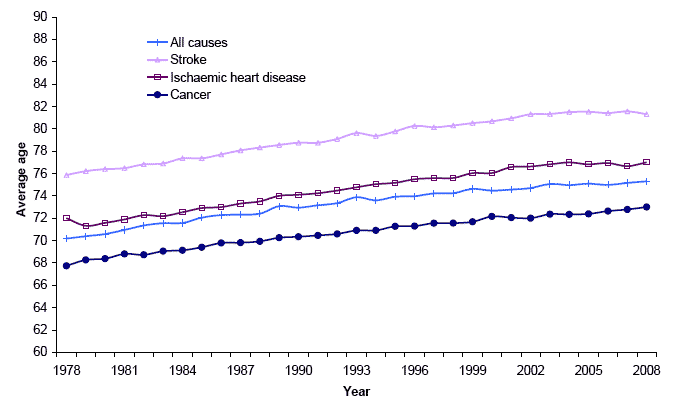
Mortality by age
About 60 per cent of deaths were of people aged 75 and over, and a further 19 per cent were between the ages of 65 and 74.
The relative stability in the total number of deaths over recent years masks significant improvements in age-specific mortality. Figure 3.3 shows, for both men and women, selected age-specific mortality rates over the last quarter of a century relative to the 1981 rates. The three age groups shown (45-64, 65-74 and 75 and over) account for around 95 per cent of all deaths.
At all these ages, there have been greater improvements in male than in female mortality. In the 45-64 age group, the death rates for men and women improved by 46 per cent and 42 per cent respectively. In the 65-74 age group, males showed an improvement of 46 per cent compared to 40 per cent for females. The greatest differential is in the 75 plus age group, where male mortality has improved by 31 per cent compared to only 14 per cent for females. These changes have narrowed the difference between female and (traditionally higher) male mortality.
Figure 3.3 Age specific mortality rates as a proportion of 1981 rate, 1981-2008
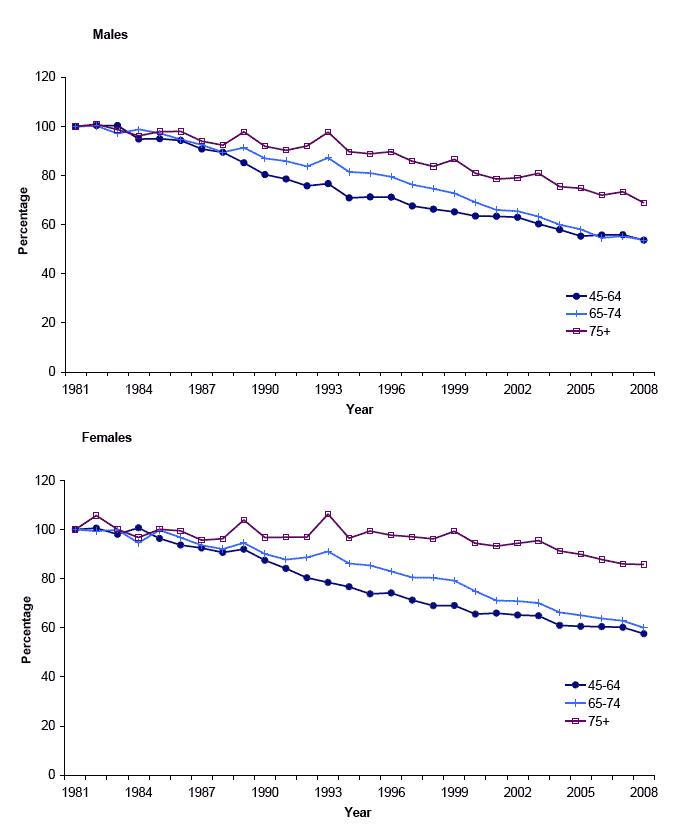
Geographical variations in mortality levels
Standardised mortality ratios (SMRs), which compare local death rates with death rates in Scotland as a whole, taking account of the different population structure of each area, are presented in Figure 3.4. Four of the 32 Scottish Council areas have a standardised mortality ratio that is more than 10 per cent higher than the overall Scottish value of 100. These are all in West Central Scotland. The worst, Glasgow City, is 27 per cent higher than the Scottish average. At the other end of the scale, 8 of the 32 Council areas have a standardised mortality ratio that is more than 10 per cent lower than the Scottish average. The lowest was East Dunbartonshire which was 19 per cent below (or better than) the Scottish average.
Similarly, standardised mortality ratios can be calculated for each of the different parts of the United Kingdom, and compared with the overall UK figure. The standardised mortality ratio for Scotland is about one-sixth (18 per cent) higher than the overall UK figure.
Figure 3.4 Standardised mortality ratios, by Council area, 2008
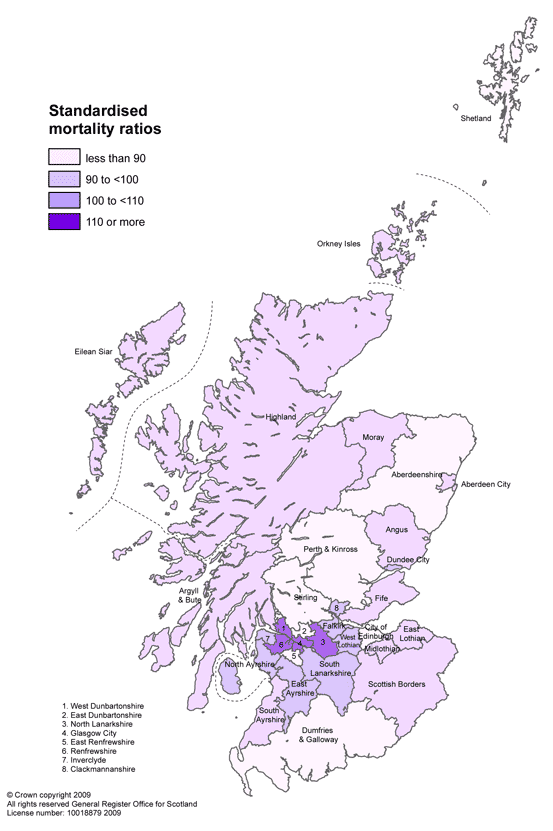
Using 2006 data, the latest available, Figure 3.5 compares the death rates for the constituent countries of the UK for selected causes after adjusting for differences in age structure. The Scottish rates for cancer, ischaemic heart disease, and cerebrovascular disease (stroke) are well above the rates for the other countries of the United Kingdom for both men and women.
Figure 3.5 Age-adjusted mortality rates, by selected cause and sex, 2006
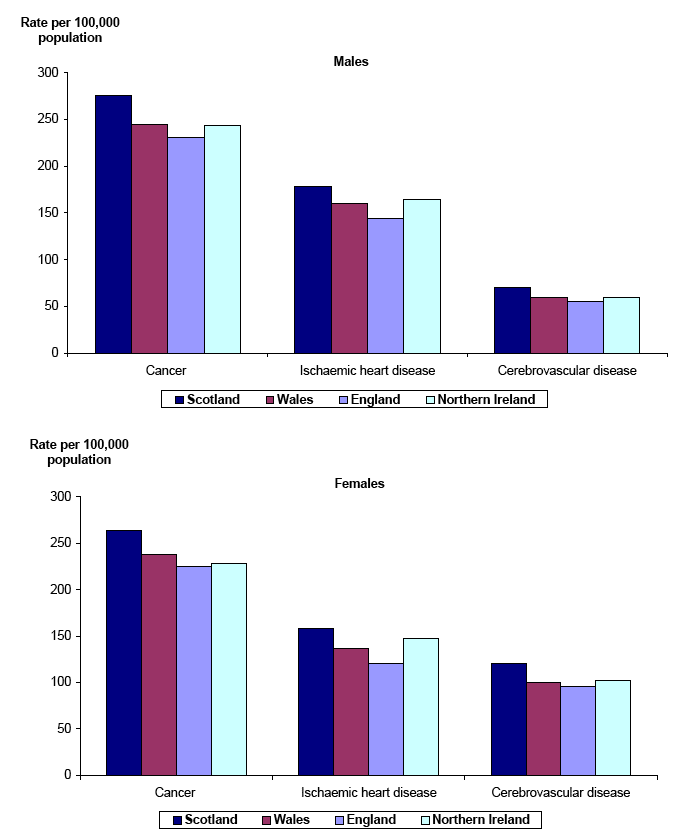
Appendix 1, Table 3 on page 92 shows the overall death rate for each of the European Union member states, and for some other countries in Europe. These are so-called "crude" death rates. They are calculated by expressing the number of deaths per thousand population. As a result, they do not take account of differences in the sex- and age-structures of the countries' populations, and (all else being equal) a country with an unusually high proportion of its population in the younger age-groups could appear to have an unusually low "crude" death rate. The figure for Scotland is higher than those for most of the countries that are shown, but this could be due, to some extent, to the structure of the Scottish population. A better way to compare Scotland's mortality with other countries' is to use the estimates of life expectancy for each country.
Life Expectancy
Although mortality rates in Scotland have generally fallen more slowly than in the rest of the UK and elsewhere in Europe, the improvements are still considerable and the impact is demonstrated in the steadily rising expectation of life.
The expectation of life at birth is a commonly used measure of mortality which is particularly helpful in comparing the ‘health’ of a nation through time and for making comparisons with other countries. Figure 3.6 shows that the expectation of life at birth in Scotland has improved greatly over the last 25 years or so, increasing from 69.1 years for men and 75.4 years for women born around 1981 to 75.0 years and 79.9 years respectively for those born around 2007. Figure 3.6 also illustrates that improvements in life expectancy at birth are projected to continue, rising to 80.4 years for men and 84.8 years for women by 2031.
Figure 3.6 Expectation of life at birth1, Scotland, 1981-2031
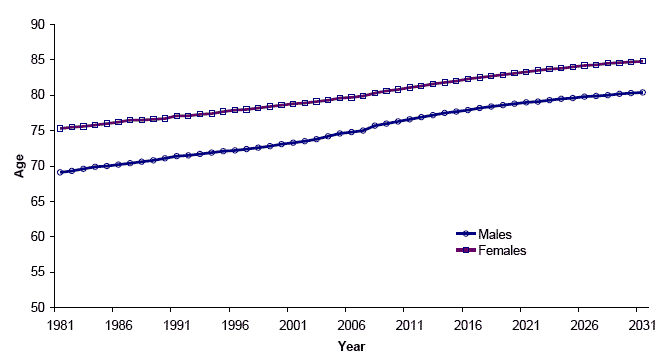
1 Source: Figures to 2007 from Interim Life Tables, ONS.
These are based on 3 years of data. For example 2007 figure uses data for 2006-2008.
Figures after 2007 are projected single year life expectancies, ONS.
However, Figures 3.7a and 3.7b show that Scottish men and women have relatively low expectation of life at birth compared to much of the European Union. The countries with lower life expectancy than Scotland were most of the Eastern European states which joined the EU on 1 May 2004 as well as Romania and Bulgaria which joined in January 2007. For men the expectation of life in Scotland is about 4 years lower than the countries with the highest expectation of life whilst for women it is almost 5 years lower.
Figure 3.7a Life expectancy at birth, 2006, selected countries, Males
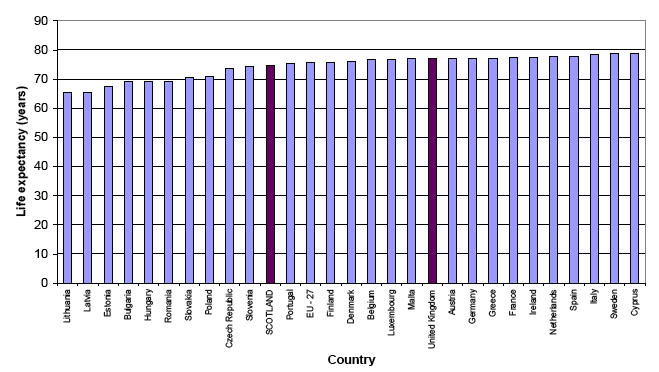
Source Eurostat and ONS
Figure 3.7b Life expectancy at birth, 2006, selected countries, Females
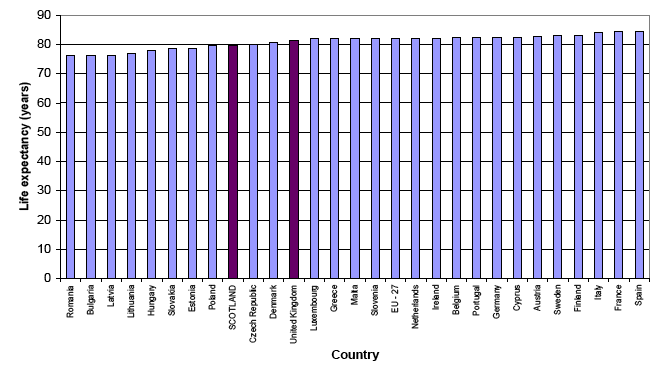
Source Eurostat and ONS
Stillbirths, perinatal deaths and infant deaths
There were 325 stillbirths registered in Scotland in 2008. Stillbirths are registered separately from live births and from deaths, and so are not included in those figures.
Perinatal deaths consist of stillbirths plus deaths in the first week of life (the latter are registered as live births and as deaths). There were 122 deaths of children who were aged under one week old, so there was a total of 447 perinatal deaths.
Infant deaths are deaths in the first year of life, all of which are registered as live births and as deaths. In total, 253 infant deaths were registered in Scotland in 2008 (including those who died in the first week of life).
As can be seen in Figure 3.8, there have been significant improvements in the rates for stillbirths, perinatal deaths and infant deaths in the period since 1971. The stillbirth rate has reduced from 13.1 per 1,000 total births (live and still) in 1971 to 5.4 in 2008, despite a change in the definition of stillbirths in 1992 which reduced the minimum period of gestation from 28 weeks to 24 weeks (thus increasing the numbers classified as stillbirths).The perinatal death rate fell from 24.5 per 1,000 total births in 1971 to 7.4 in 2008 and the infant death rate fell from 19.9 per 1,000 live births in 1971 to 4.2 in 2008.
Figure 3.8 Stillbirth, perinatal and infant death rates, per 1,000 births, Scotland 1971-2008
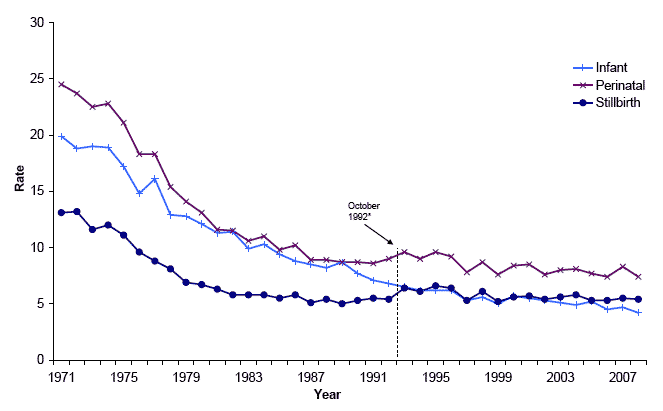
* Change in definition from 28 to 24 weeks gestation
Whilst the current rates are comparable to those for the UK as a whole, Figures 3.9 and 3.10 show that there are several European countries that have significantly lower rates (see also Appendix 1, Table 3).
Figure 3.9 Stillbirth rate per 1,000 live and still births, selected countries, latest available figures
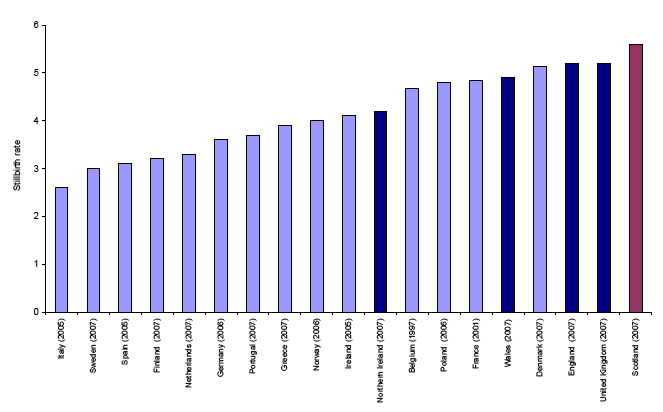
Figure 3.10 Infant death rate per 1,000 live births, selected countries, latest available figures
